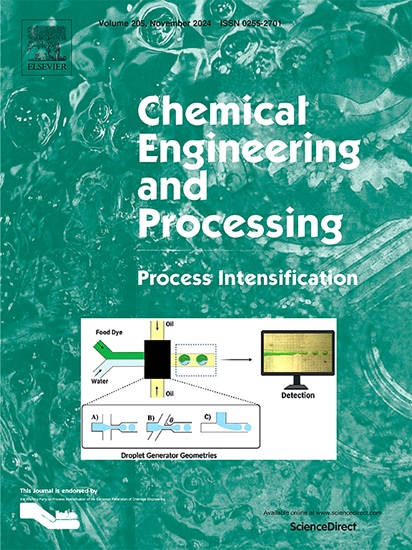羟乙基纤维素作为综合盐水淡化、CO 2捕获和提高石油采收率的多功能剂
IF 3.9
3区 工程技术
Q3 ENERGY & FUELS
Chemical Engineering and Processing - Process Intensification
Pub Date : 2025-06-22
DOI:10.1016/j.cep.2025.110414
引用次数: 0
摘要
该研究提出了一种将羟乙基纤维素(HEC)整合到可持续框架中的新方法,针对三个主要挑战:盐水处理、二氧化碳(CO 2)捕获和提高石油采收率(EOR)。在可控的实验条件下,研究了HEC与高盐度盐水和CO 2气体的物理化学相互作用。HEC的加入通过增强碳酸盐沉淀和促进气相和水相之间的传质,显著提高了CO₂捕获效率,最高可达99.2%。同时,HEC通过促进离子络合和选择性沉淀来促进盐水淡化,使总盐度降低32.4%。实验测量表明,包括镁(Mg 2 +)和钙(Ca 2 +)在内的卤水离子浓度显著降低,进一步验证了该工艺促进的离子交换和沉淀机制。除了水处理和气体捕获能力外,hec处理的盐水还表现出良好的界面张力特性。岩心驱油和界面张力测量表明,由于HEC能够改变多孔介质中的润湿性和稳定驱油前缘,因此可以将采收率提高65%。这些综合结果突出了HEC作为一种生物衍生的可生物降解添加剂的多功能性,不仅可以解决与盐水处理和温室气体排放相关的环境挑战,还有助于石油作业中的资源回收。研究结果支持将HEC整合到连接水处理、气候缓解和能源回收的循环经济模型中的可行性。这项工作为扩大生物聚合物增强海水淡化和碳捕获系统的实际应用奠定了基础。本文章由计算机程序翻译,如有差异,请以英文原文为准。

Hydroxyethyl cellulose as a multifunctional agent for integrated brine desalination, CO₂ capture, and enhanced oil recovery
This study presents a novel approach for integrating hydroxyethyl cellulose (HEC) into a sustainable framework targeting three major challenges: brine treatment, carbon dioxide (CO₂) capture, and enhanced oil recovery (EOR). Utilizing a modified Solvay process within an inert particle-spouted bed reactor, the research investigates the physicochemical interactions of HEC with high-salinity brine and CO₂ gas under controlled experimental conditions. The incorporation of HEC significantly improved CO₂ capture efficiency, reaching a maximum of 99.2 %, by enhancing carbonate precipitation and facilitating mass transfer between gaseous and aqueous phases. Simultaneously, HEC contributed to brine desalination by promoting ionic complexation and selective precipitation, achieving up to 32.4 % reduction in total salinity. Experimental measurements showed a significant reduction in brine ion concentrations including magnesium (Mg²⁺), and calcium (Ca²⁺) further validating the ion-exchange and precipitation mechanisms facilitated by the process. In addition to water treatment and gas capture capabilities, HEC-treated brine exhibited favourable interfacial tension properties. Core flooding and interfacial tension measurements demonstrated that HEC could enhance oil recovery by up to 65 % due to its ability to alter wettability and stabilize displacement fronts in porous media. These combined results highlight the multifunctionality of HEC as a bio-derived, biodegradable additive that not only addresses environmental challenges associated with brine disposal and greenhouse gas emissions but also contributes to resource recovery in petroleum operations. The outcomes support the feasibility of integrating HEC into circular economy models that connect water treatment, climate mitigation, and energy recovery. This work lays the foundation for scaling up bio-polymer-enhanced desalination and carbon capture systems for real-world applications.
求助全文
通过发布文献求助,成功后即可免费获取论文全文。
去求助
来源期刊
CiteScore
7.80
自引率
9.30%
发文量
408
审稿时长
49 days
期刊介绍:
Chemical Engineering and Processing: Process Intensification is intended for practicing researchers in industry and academia, working in the field of Process Engineering and related to the subject of Process Intensification.Articles published in the Journal demonstrate how novel discoveries, developments and theories in the field of Process Engineering and in particular Process Intensification may be used for analysis and design of innovative equipment and processing methods with substantially improved sustainability, efficiency and environmental performance.

 求助内容:
求助内容: 应助结果提醒方式:
应助结果提醒方式:


